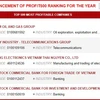Commercial banks have begun dropping interest rates on medium and long-term loans in response to recent State Bank of Vietnam measures to ease upward pressures on rates, confirmed an official of the State Bank’s monetary statistics and forecasting department, who asked to remain anonymous.
“The change is in conformity with Government policy and State Bank of Vietnam measures to lower lending interest rates,” he said.
The central bank recently injected additional capital into the commercial banking system via open market operations and took other steps to encourage banks to lower rates.
State Bank Governor Nguyen Van Giau has said that the central bank would continue to support commercial banks with more capital in order to keep interest rates in check and reduce the inflationary pressures caused by high interest costs.
State-owned banks like Agribank, Vietcombank, Vietinbank and the Bank for Investment and Development of Vietnam (BIDV) have dropped rates to around 14 percent from a recent spike of 16-18 percent when rates were deregulated, while private banks were seeing slightly higher rates of 15-18 percent.
A representative of Asia Commercial Bank, who asked to remain unnamed, said the bank had 30 trillion VND (1.6 billion USD) to lend at 14.5-15 percent a year for medium- and long-term loans.
While the Government recently moved to deregulate interest rates and allow market or negotiated rates on medium- and long-term loans, hoping more competitive rates would help reduce overheating of the economy and reduce economic pressures, this policy shift did not work out in Vietnam’s situation, in which consumption was already limited, commented economist Bui Kien Thanh.
The immediate effect was to raise the input and production costs of businesses, said Thanh.
“Enterprises would have to cut production and raise product prices, since there is no way they could absorb market interest rates of 17-20 percent,” said former State Bank Governor Cao Sy Kiem.
Kiem also said that achieving economic growth targets of 5-7 percent would be impossible in face of high interest rates.
Enterprises were only able to make a profit if prevailing interest rates were around 7-8 percent, argued Thanh.
Vietnam Vegetable and Fruit Association chairman Le Van Anh said member enterprises of his association, forced to borrow recently at 15-17 percent, had complained that the costs of servicing such loans were too high to maintain production to full capacity.
Many enterprises simply avoided borrowing altogether, reflected in credit growth in Vietnamese dong during the first quarter of this year of just 0.57 percent.
The State Bank would hold the line on interest rates to keep inflation below 7 percent and achieve a growth rate of 6.5 percent, Giau has said.
“The change is in conformity with Government policy and State Bank of Vietnam measures to lower lending interest rates,” he said.
The central bank recently injected additional capital into the commercial banking system via open market operations and took other steps to encourage banks to lower rates.
State Bank Governor Nguyen Van Giau has said that the central bank would continue to support commercial banks with more capital in order to keep interest rates in check and reduce the inflationary pressures caused by high interest costs.
State-owned banks like Agribank, Vietcombank, Vietinbank and the Bank for Investment and Development of Vietnam (BIDV) have dropped rates to around 14 percent from a recent spike of 16-18 percent when rates were deregulated, while private banks were seeing slightly higher rates of 15-18 percent.
A representative of Asia Commercial Bank, who asked to remain unnamed, said the bank had 30 trillion VND (1.6 billion USD) to lend at 14.5-15 percent a year for medium- and long-term loans.
While the Government recently moved to deregulate interest rates and allow market or negotiated rates on medium- and long-term loans, hoping more competitive rates would help reduce overheating of the economy and reduce economic pressures, this policy shift did not work out in Vietnam’s situation, in which consumption was already limited, commented economist Bui Kien Thanh.
The immediate effect was to raise the input and production costs of businesses, said Thanh.
“Enterprises would have to cut production and raise product prices, since there is no way they could absorb market interest rates of 17-20 percent,” said former State Bank Governor Cao Sy Kiem.
Kiem also said that achieving economic growth targets of 5-7 percent would be impossible in face of high interest rates.
Enterprises were only able to make a profit if prevailing interest rates were around 7-8 percent, argued Thanh.
Vietnam Vegetable and Fruit Association chairman Le Van Anh said member enterprises of his association, forced to borrow recently at 15-17 percent, had complained that the costs of servicing such loans were too high to maintain production to full capacity.
Many enterprises simply avoided borrowing altogether, reflected in credit growth in Vietnamese dong during the first quarter of this year of just 0.57 percent.
The State Bank would hold the line on interest rates to keep inflation below 7 percent and achieve a growth rate of 6.5 percent, Giau has said.



















